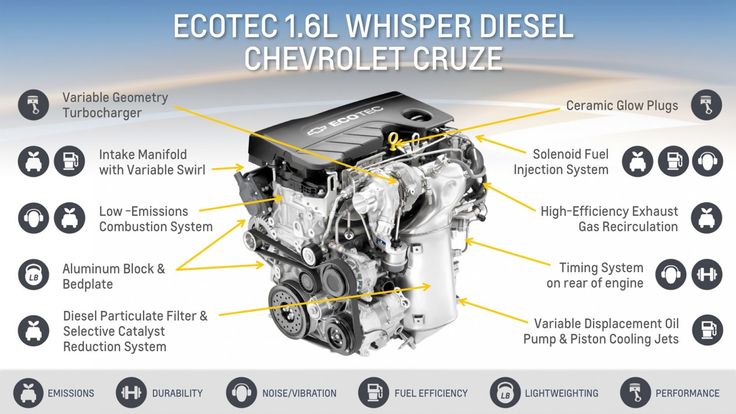The 2014 Chevy Cruze Diesel is a marvel of engineering, offering a robust combination of fuel efficiency and robust performance. A critical aspect of the Cruze Diesel is its engine configuration, which is where we delve into the intricacies of its mechanics via the engine diagram. This article aims to explore the fundamentals of the Chevy Cruze Diesel engine, detailed components, and their functionalities, while also addressing the maintenance and common issues that may arise. Understanding these elements can significantly enhance your driving experience and ensure longevity for this outstanding vehicle.
The Chevy Cruze Diesel’s engine is a 2.0-liter turbocharged four-cylinder engine, which sets it apart from its gasoline counterparts. This particular engine design offers high torque at low RPMs, enhancing acceleration and overall driving dynamics. The power generated by this engine not only caters to performance but also contributes to greater fuel economy—an outstanding advantage for a diesel vehicle. On a broader scale, this means that drivers are not only investing in an efficient vehicle but also one that is designed with longevity in mind, thereby offering greater value over its lifespan.
Examining the engine diagram of the 2014 Chevy Cruze Diesel reveals several intricate components that work in harmony to deliver exceptional performance. Starting with the turbocharger, this vital component compresses the intake air, enabling more power to be generated within the cylinders. In this particular engine, the turbocharger is known for its quick spool-up time, ensuring that drivers can enjoy responsive acceleration when needed.
Next, we find the fuel injection system, specifically a common rail direct injection setup. This technology allows for precise control over fuel delivery, maximizing efficiency while minimizing emissions. Its ability to adapt the injection timing based on engine demand exemplifies modern advancements in diesel technology. The common rail system optimizes combustion, which is pivotal for both power and fuel economy, reinforcing the Cruze Diesel’s reputation as an intelligent choice for environmentally-conscious drivers.
The intercooler is another crucial component, located directly after the turbocharger. It cools the compressed air before it enters the engine, denser air leads to more oxygen for combustion. This allows for a more potent mix of air and fuel, resulting in improved performance and efficiency. Moreover, maintaining the intercooler in optimal condition ensures that the engine performs effectively at various temperatures and conditions.
Moving on to the engine’s cooling system, the 2014 Chevy Cruze Diesel employs a liquid cooling system designed to regulate temperature effectively. The thermostat and radiator are essential in this process, ensuring that the engine maintains an optimal operating temperature. An engine that operates within its ideal thermal range not only performs better but also suffers less wear over time. Regular checks for leaks, coolant levels, and the condition of hoses can help maintain this aspect of one’s vehicle.
The engine diagram also highlights the exhaust system components, including the diesel particulate filter (DPF) and the catalytic converter. The DPF plays a vital role in trapping soot and particulates from the exhaust, significantly reducing emissions. However, it requires periodic regeneration to clean itself. Understanding this process is essential for owners, as it can affect engine performance if not adequately managed. Additionally, the catalytic converter ensures that harmful substances are transformed into less harmful emissions before they are expelled into the atmosphere.
As a driver of a 2014 Chevy Cruze Diesel, being aware of common issues can also enhance your ownership experience. One prevalent concern among diesel vehicle owners is injector failure. Symptoms can often present as rough idling or decreased power, requiring swift attention. Regular maintenance checks can help in identifying potential issues early, thereby avoiding costly repairs down the line.
Furthermore, the engine oil used in diesel vehicles is critical. The 2014 Cruze Diesel requires the use of low SAPS (sulfated ash, phosphorus, and sulfur) oils to protect the DPF and ensure smooth operation. Following the manufacturer’s specifications not only preserves engine performance but also enhances emissions control, aligning with modern environmental standards.
Another noteworthy mention is the engine’s timing belt, which must be inspected regularly to ensure it is in good condition. A worn or broken timing belt can lead to catastrophic engine failure. Adhering to a maintenance schedule for replacement can safeguard the heart of the engine—avoiding unexpected downtimes or expensive repairs.
In conclusion, the 2014 Chevy Cruze Diesel engine, through its sophisticated design and advanced technologies, represents a significant stride in modern automotive engineering. From the turbocharger to the intercooler and beyond, each component plays a pivotal role, contributing to the vehicle’s efficiency and power. For drivers, a good understanding of the engine diagram can illuminate how each part interacts, paving the way for better maintenance practices and ultimately, enhancing the driving experience. Embarking on ownership or even a simple joyride in the Cruze Diesel means embracing a vehicle that offers not just utility but a blend of performance and efficiency that is hard to match in today’s market.
